HTC One vs Xperia Z
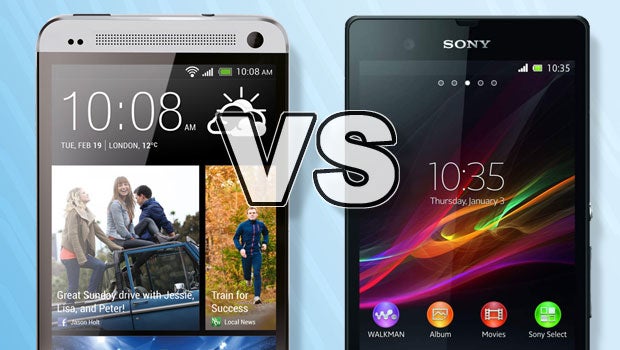
The Xperia Z and HTC One are Sony and HTC’s most high-profile Android phones of the year. They have big screens, big feature lists and big marketing budgets behind them.
But once you’ve cut through all the blather, which is the better phone? We’ve compared the HTC One and Xperia Z to find out.
HTC One vs Xperia Z – Design
HTC One – Aluminium body, Gorilla Glass 2 front, plastic side trim, 143g
Sony Xperia Z – Glass front and rear, IP57 weatherproofing, plastic sides, 146g
A case of glass versus metal, the HTC One has a curvy aluminium body while the Sony Xperia Z is more angular, with flat glass plates on its front and back.
Although they are both made from premium materials, the HTC One feels far more impressive in-hand. Its curves and the cool ‘n’ hard feel of metal easily outdo the Xperia Z, which oddly enough feels a little plasticky in spite of its glass outer parts. 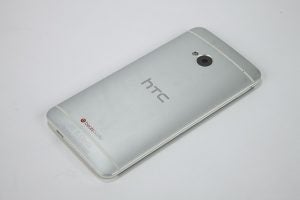
We also think the HTC One is better-looking. It’s largely down to design moves Sony had to make in order to achieve one of the Xperia Z’s key features – weather-proofing.
The phone is certified to IP57 level, which means it can be immersed in water and is dustproof. It manages this by using rubber-edged flaps that keep such elements out – they’re rubber bungs for the phone’s sockets, essentially. 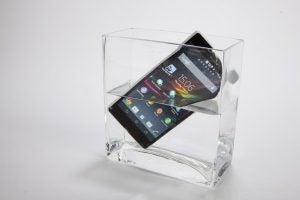
Some people love this feature, but it does ensure the phone’s sides are riddled with seams. It doesn’t have the simple purity of the HTC One. And its hard-edged style doesn’t feel as good in the hand, either.
If being able to use your phone in the bath without any danger is a high priority, though, the Sony Xperia Z is the clear winner. ![]()
HTC One vs Xperia Z – Screen
HTC One – 4.7-inch 1080p IPS screen
Sony Xperia Z – 5-inch 1080p LCD screen
Specs-wise, both the HTC One and Xperia Z are top mobile contenders thanks to their 1080p screens. Until 2013, the most you could hope for was 720p. They both use LCD-type panels too – the Sony’s is a little larger than HTC’s at a full five inches rather than 4.7.
In use, there’s quite a disparity between the phones’ screen performance – and the HTC One is the superior of the two.
Contrast, colour reproduction, the clarity of images and viewing angles are all significantly better in the HTC phone. To an almost alarming degree at times.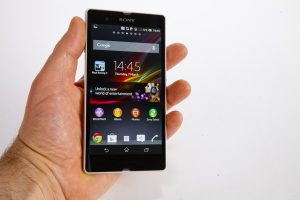
Sony has employed some battery-saving techniques in the Xperia Z that deliberately reduce contrast, and to our eyes they may be a bit too severe. For a phone that appears screen-centric, the Xperia Z display isn’t too hot.
Sony also ships the Xperia Z with a plastic screen protector on top that extends right to the edges of the display. It removes the need to buy one, and is perfectly fitted where doing so manually can be a nightmare, but it alters the feel of the touchscreen and spoils the screen’s visual finish a touch. ![]()
HTC One vs Xperia Z – Power
HTC One – Quad-core Snapdragon 600 1.7GHz, 2GB RAM
Sony Xperia Z – Quad-core Snapdragon S4 1.5GHz, 2GB RAM
The HTC One has a slightly more advanced processor than the Sony Xperia Z. It’s a Snapdragon 600-based chip, where the Xperia Z has a Snapdragon S4 chipset.
The former uses Krait 300 cores while the Xperia Z has slightly less advanced Krait 200 cores, which are clocked a little slower too – 1.5GHz instead of 1.7GHz.
Benchmarks like AnTuTu show that there’s a significant, if not catastrophic, difference between the two processors. Both use the same Adreno 320 GPU, though, which will help to keep gaming performance reasonably level. 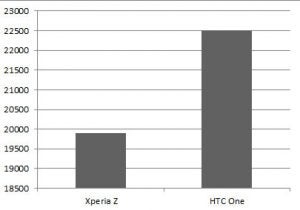
Day-to-day performance is not hugely different, though. These are very fast phones, despite their use of custom interfaces, which can sometimes slow down a phone. ![]()
HTC One vs Xperia Z – Software
HTC One – Android 4.2 with HTC Sense
Sony Xperia Z – Android 4.2 with custom UI
Both these phones use fairly up-to-date versions of Android. They use Android 4.2 – and while Android 4.3 has been leaked, it’s not a big upgrade.
Each phone has its own custom user interface made by their respective manufacturer. The HTC One’s interface is called HTC Sense – the name HTC has used since it started making own-brand phones years ago. 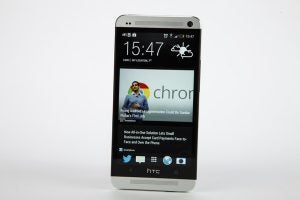
This new version is quite different from the Sense of old, though – at least fresh out of the box. Its top feature is BlinkFeed, which is an animated, scrolling widget that provides you with daily updates. They can be new stories from selected websites, or updates from your social networks.
It’s there for you customise, and wants to become the ‘front page’ of your phone. It takes up the default home screen as standard and cannot be removed. To get rid of it you have to change the default home screen and simply pretend it’s not there.
Do so and you can make the HTC One’s Sense UI look much like it did in previous phones – the classic-style HTC clock widget is here more-or-less intact. HTC has tried to make the apps menu look simple and spare too, by reducing the number of icons that appear in a row.
Otherwise, though, HTC Sense offers few extra bells and whistles, concentrating instead on how the phone looks and feel. And it works – it’s an interface that’s very easy to live with.
The Xperia Z interface has the same visual style Sony has bunged-into its phones for the last few years. It’s all colourful, moody swirls, and uses a translucent apps menu that keeps the home screen background in view while you scan through your apps. 
Other than the Sony look, the interface’s main additions are media-related. There’s a bespoke music player app called Walkman, and a video player named – imaginatively – Movies.
It’s a good-looking interface, but for its slightly more dynamic approach, we’ll hand the victory to HTC once more. ![]()
HTC One vs Xperia Z – Camera
HTC One – 4-megapixel Ultrapixel camera, f/2.0, LED flash
Sony Xperia Z – 13-megapixel camera, f/2.4, LED flash
The camera approaches taken by HTC and Sony for their 2013 flagship Androids are completely different.
Sony has played it safe, using the latest 13-megapixel sensor seen in the Samsung Galaxy S4 and LG Optimus. It’s no surprise given this all-conquering camera sensor is made by Sony. 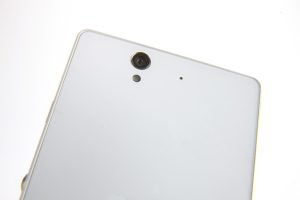
The problem with using such a high-megapixel phone sensor is that the pixels that make up all those megapixels are tiny. They are just 1.1 microns across where the HTC One’s are double the size at 2 microns.
HTC’s strategy is to use larger sensor pixels than the competition, for better low-light performance. The physics of this are simple – larger pixels let the HTC One’s sensor grab more light-per-pixel in the same exposure window.
It works too. The HTC One offers much better low-light performance than the Xperia Z – this effect is made all the more noticeable by the lens array. The HTC One has a faster f/2.0 lens than the Xperia Z’s lowly f/2.4. This is relatively slow compared to the top phones of the year. 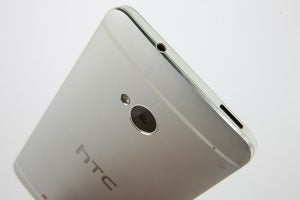
Put the two phones in bright daylight and give them a detail-filled object to capture, though, and the Xperia Z comes out on top. The 4-megapixel sensor of the HTC has its limits – even if it does use impressive-sounding Ultrapixel technology. ![]()
Verdict
There’s little doubt that the Sony Xperia Z and HTC One are two of the year’s top Android phones. However, the HTC betters the Sony in a few too many respects for them to be thought of as even.
The HTC One looks and feels better, has more attractive software, a more dynamic camera and more power on tap. The Xperia Z has water resistance and better camera detail in bright situations, but we favour the HTC.


